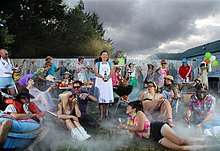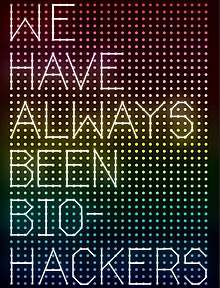Center for Genomic Gastronomy
The Center for Genomic Gastronomy[1] is an independent research group that examines the biotechnology and biodiversity of human food systems. The Center was founded in 2010 in Portland, Oregon and currently has research nodes in Bergen, Porto, Dublin and Chennai. They are sometimes described as an artist-led think tank.
The Center for Genomic Gastronomy | |
|---|---|
 | |
| Nationality | United States / Norway |
| Known for | Contemporary Art |
Notable work | The Glowing Sushi Cooking Show (2010), Smog Tasting (2011-present), EDIBLE: The Taste of Things to Come [Exhibition] (2012), Art Meat Flesh (2012-2016), Food Phreaking (2013-present), LOCI Food Lab (2014-present), FIELD TEST: Radical Adventures in Future Farming (2016), To Flavour Our Tears (2016-2019), FOOD: Bigger than the Plate [Exhibition] (2019) |
| Website | genomicgastronomy.com |
Along with groups such as Fallen Fruit, Futurefarmers, Tissue Culture & Art Project, Environmental Health Clinic they have been described as being part of a green avant-garde. [2]
Mission & Research
The mission of the group is to map food controversies, prototype alternative culinary futures[2] and imagine a more just, biodiverse & beautiful food system.[3]
Their Research is split into five primary research streams:
- Cultures of Biotechnology
- Eating in the Anthropocene
- Databases of Taste
- Protein Futures
- Food Phreaking
Images
 WHABBH poster designed by the Center for Genomic Gastronomy (2010)
WHABBH poster designed by the Center for Genomic Gastronomy (2010) Glowing Sushi Cooking Show (2010)
Glowing Sushi Cooking Show (2010) Glowing Sushi, Not In California Roll (2010)
Glowing Sushi, Not In California Roll (2010) Cobalt-60 Sauce, Bottle. (2013)
Cobalt-60 Sauce, Bottle. (2013)
Publications and Press
The Center for Genomic Gastronomy's research has been featured and reviewed in The Lancet,[4] Nature,[5][6] and Chemical & Engineering News.[7]
Their work has been featured in books and anthologies such as Bio Art: Altered Realities[8] and Neo.Life: 25 Visions for The Future of Our Species.
References
- Global Appetites: American Power and the Literature of Food. (2013), Allison Carruth, Cambridge University Press. [9]
- Food Hackers: Political and Metaphysical Gastronomes in the Hackerspaces. (2015), Denisa Kera, Zack Denfeld, Cathrine Kramer, GASTRONOMICA: The Journal of Critical Food Studies. Vol. 15 No. 2, Summer 2015; (pp. 49-56).[10]
- Experimental Eating (2015). Black Dog Publishing. [11]
- Bioart Kitchen: Art, Feminism and Technoscience (2016), Lindsay Kelley, I.B. Tauris. [12]
- Literature and Food Studies (2017), Amy L. Tigner, Allison Carruth. Routledge.
- Food Futures: Speculative Performance in the Anthropocene (2017), Shelby Brewster, The Journal of American Drama and Theatre, Volume 29, Number 2. [13]
- Edible Speculations: Designing for Human-Food Interaction (2018), Markéta Dolejšová. [14]
- Food: Eating Tomorrow: Bigger Than The Plate. (2019), Catherine Flood and May Rosenthal, V&A. [15]
Selected works
The Glowing Sushi Cooking Show
The Glowing Sushi Cooking Show (2010) was an online cook show that "uses everyday ingredients and some simple kitchen chemistry to explore cutting edge biotechnology."[16] and "finds an unexpected use for the first genetically engineered animal you can buy."[17]
According to scholar Lindsay Kelley "Fish do not usually cross the pet/meat divide, with pet species kept separate from species that are farmed or caught as food. Glowing Sushi confuses these boundaries, collapsing the laboratory, kitchen, and aquarium to illustrate the ways in which a Glo-Fish's tranimality crosses and complicates relations between jellies, zebrafish, and humans."[18]
EDIBLE Exhibition
EDIBLE: The Taste of Things to Come (2012) was an exhibition curated by the Center for Genomic Gastronomy at Science Gallery, Trinity College Dublin.
In addition to exhibits, the show included events like curated meals, talks from local and international foodies, and selected recipes. A major component of the exhibition were the feeding times, prepared by the in-gallery kitchen, where visitors got the chance to experience various ingredients and curious tasters such as the vegan ortolan created by the Center for Genomic Gastronomy.[19]
Food Phreaking
FOOD PHREAKING (2013-present) is the journal of experiments, exploits and explorations of the human food system. Each issue contains stories about the space where food, technology & open culture meet.[20] In the introduction of the book Literature and Food Studies the authors use Food Phreaking as a case study to argue for the importance of close readings of vernacular literary practices.[21]
Influences
The Center for Genomic Gastronomy has been influenced by the following artists: [11]
See also
- Molecular Gastronomy
- Do-it-yourself biology
Notes
- "The Center for Genomic Gastronomy". genomicgastronomy.com. Retrieved 2020-03-09.
- Carruth, Allison (Winter 2014). "The Green Avant-Garde: Food Hackers and Cyberagrarians". Resilience: A Journal of the Environmental Humanities. 2 (1): 48–65.
- Fargione, Daniela (December 2019). "Utopian and Dystopian Meals: Food Art, Gastropolitics and the Anthropocene". COSMO: Comparative Studies in Modernism. 15 (2019). doi:10.13135/2281-6658/4028.
- Lang, Tim (September 2019). "Food as spectacle". The Lancet. 394 (10203): 999–1000. doi:10.1016/S0140-6736(19)32097-5.
- King, Anthony (21 March 2012). "Nutrition: Chew on this". Nature. 483 (7390): 404. Bibcode:2012Natur.483..404K. doi:10.1038/483404a.
- King, Anthony (30 March 2016). "Agriculture: Future farming". Nature. 531 (7596): 578–579. Bibcode:2016Natur.531..578K. doi:10.1038/531578a.
- Halford, Bethany. "Smog Delicacies, Fizzy Coffee Fix". Chemical & Engineering News. Retrieved 24 March 2020.
- William, Myers (2015). Bio art : altered realities. Thames & Hudson. ISBN 978-0500239322.
- Carruth, Allison (2013). Global appetites : American power and the literature of food. Cambridge University Press. ISBN 978-1107032828.
- Kera, Denisa; Denfeld, Zack; Kramer, Cathrine (May 2015). "Food Hackers". Gastronomica. 15 (2): 49–56. doi:10.1525/gfc.2015.15.2.49.
- Experimental eating. Black Dog Publishing. 2015. ISBN 978-1908966407.
- Kelley, Lindsay (2016). Bioart kitchen : art, feminism and technoscience. I.B. Tauris. ISBN 978-1784534134.
- Brewster, Shelby (Spring 2017). "Food Futures: Speculative Performance in the Anthropocene". The Journal of American Drama and Theatre. 29 (2).
- Dolejšová, Markéta (2018). Edible Speculations: Designing for Human-Food Interaction. PQDT - Global. ISBN 9781082943409.
- Flood, Catherine (2019). Food : bigger than the plate. V&A. ISBN 978-1851779765.
- "Glowing Sushi Cooking Show". Glowing Sushi Cooking Show. Retrieved 24 March 2020.
- "Glowing Sushi Cooking Show". The Center for Genomic Gastronomy. Retrieved 24 March 2020.
- Kelley, Lindsay (17 May 2017). "Menagerie À Tranimals". Angelaki. 22 (2): 97–109. doi:10.1080/0969725X.2017.1322824.
- "Edible Exhibition". The Center for Genomic Gastronomy. Retrieved 24 March 2020.
- "Food Phreaking". Food Phreaking. Retrieved 25 March 2020.
- Tigner, Amy L.; Carruth, Allison (2017). Literature and food studies. Routledge. ISBN 978-0415641210.